Introduction: In this article, Melissa Davenport Berry writes about the unveiling of “The Pilgrim” statue in Philadelphia, Pennsylvania, in April 1905. Melissa is a genealogist who has a website, americana-archives.com, and a Facebook group, New England Family Genealogy and History.
On 29 April 1905, the New England Society of Pennsylvania unveiled a bronze statue called “The Pilgrim” at City Hall Plaza in Philadelphia to honor the hardy pioneers who arrived on the Mayflower in Plymouth, Massachusetts, in 1620.
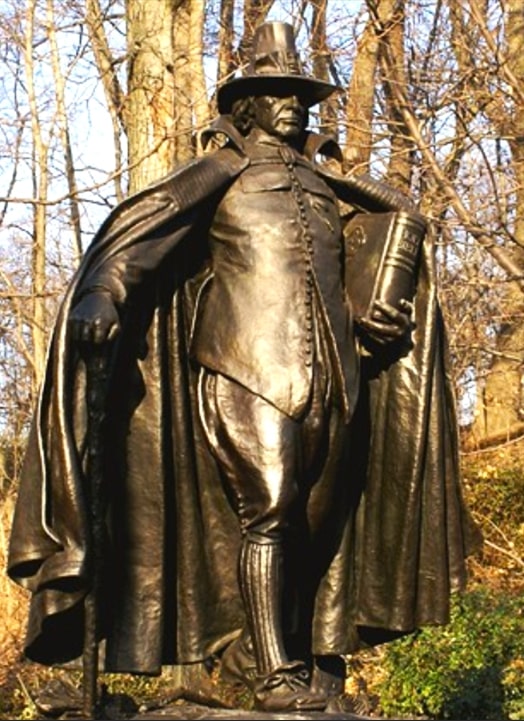
A local newspaper covered the unveiling of the statue with a headline reading: “City of Penn Given ‘The Pilgrim’ by Descendants of Puritan Stock.”
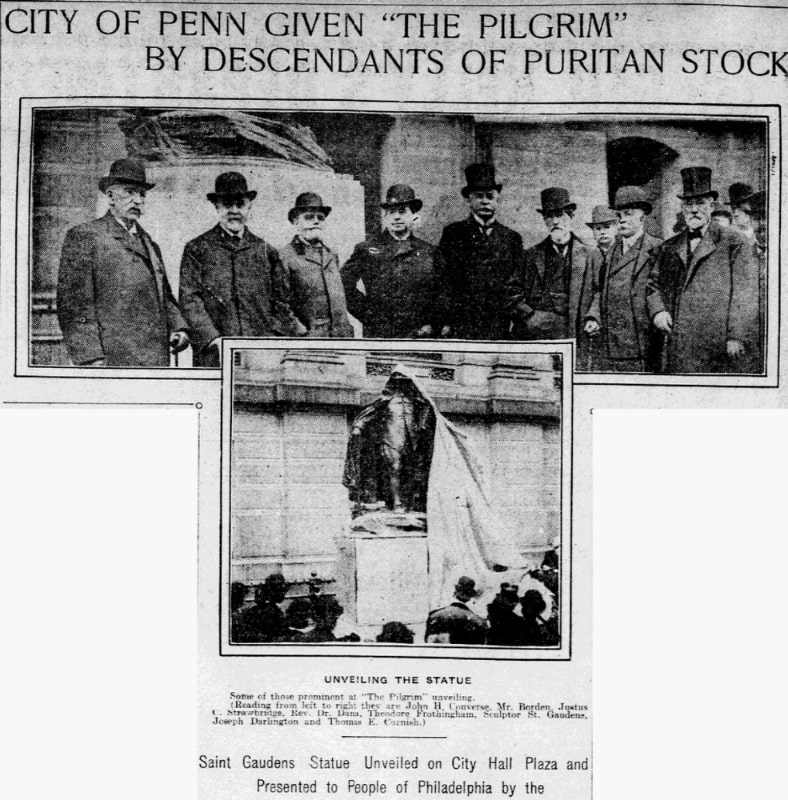
The top photo in this newspaper article shows some of the New England Society members who participated in the unveiling of the bronze statue and the sculptor himself. From left to right: John Heman Converse, Artemus Bigelow Borden, Edward Payson Borden, Justus Clayton Strawbridge, Rev. Dr. Stephen Winchester Dana, Theodore Frothingham, Sculptor Augustus Saint-Gaudens, Joseph Darlington, and Thomas Everett Cornish.
This article reports:
“The Pilgrim,” yesterday unveiled, stood frankly forth on City Hall plaza, in the presence of the Quaker countenance of William Penn and almost within hearing of the Liberty Bell, still ringing with the Scriptural proclamation of liberty throughout the land.
President Theodore Frothingham, of the New England Society of Pennsylvania, pulled the string, when the heroic figure of “The Pilgrim,” by Augustus Saint-Gaudens, America’s foremost sculptor, looked down upon the two hundred or more descendants of New England [Pilgrims]. Standing in the picture at the moment of the unveiling were men who could look back to ancestors who, like the bronze figure, had both feet on the Rock, and had characters to match.
The news clip notes that Frothingham and the spectators were moved by love for native land and “The Pilgrim” was a gesture of deep affection that carries through several periods of history.
One can view the bronze Pilgrim and look back at Miles Standish, Paul Revere, and other New England heroes and be inspired by their patriotism, unified by the Liberty Bell.
I believe the same sentiment present in the New England Society members prompted the building of the National Monument to the Forefathers in Plymouth, Massachusetts.
Like other structures, monuments, and statues across the country, “The Pilgrim” statue and the National Monument to the Forefathers represent a guidestone, and remind us of the eternal spirit within us – just as it was in every Pilgrim who crossed the sea to build a new Jerusalem.
This same spirit drove the founding fathers, and generations later it drove these men who stood before the unveiling of “The Pilgrim.”
Much like the Pilgrims of Plymouth Colony, their credo was to build, create, and serve while maintaining true spiritual principles.
Here are a few examples of the men who organized, funded, and provided the bronze statue for the city of Philadelphia. They were motivated, driven, self-made entrepreneurs and civil servants.
Edward Payson Borden
Edward Payson Borden (1836-1916), son of Richard and Abby Walker (Durfee) Borden, a member of the firm of Shortridge, Borden & Co., manufacturers of print goods, and president of the Richard Borden Mfg. Co., of Fall River, as well as vice president, secretary and treasurer of the Pulaski Iron Co., of Pulaski, Virginia.
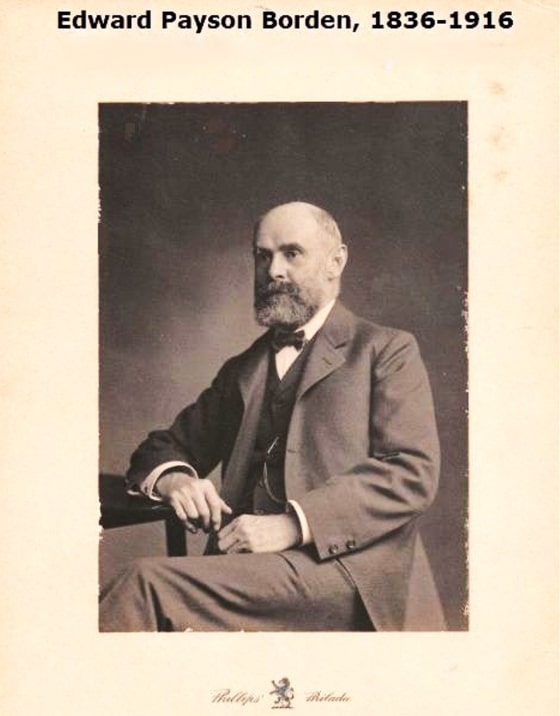
In addition, Borden became connected with Lehigh Valley Railroad and was an engineer during construction of the Reading Terminal Station in Philadelphia, and of the Willow Grove Park Construction, Philadelphia. He was vice-president and director of the Pelham Trust Company, Philadelphia, and president of Wm. Silver & Company, Inc. He was also a member of Company “B,” Engineers, National Guard of Pennsylvania, and a trustee of Lafayette College.
Thomas Everett Cornish
Thomas Everett Cornish (1838-1924), son of Plymouth County Captain Thomas Everett and Zoraday (Thompson) Cornish, an electrical supply dealer who became the first president of the Bell Telephone Co. of Philadelphia.
Charles Emory Smith
Presidential Cabinet Secretary Charles Emory Smith, one of the speakers the day of “The Pilgrim” statue’s unveiling who is not in the photo above, was an American journalist, teacher, and politician who had many prominent offices and roles during his life. To name a few: he served as U.S. Postmaster General in the cabinet of Presidents William McKinley and Theodore Roosevelt; U.S. Ambassador to Russia; and the editor and proprietor of the Philadelphia Press.
He is the son of Emory Boutelle and Avrilla Topliff (Royce) Smith.
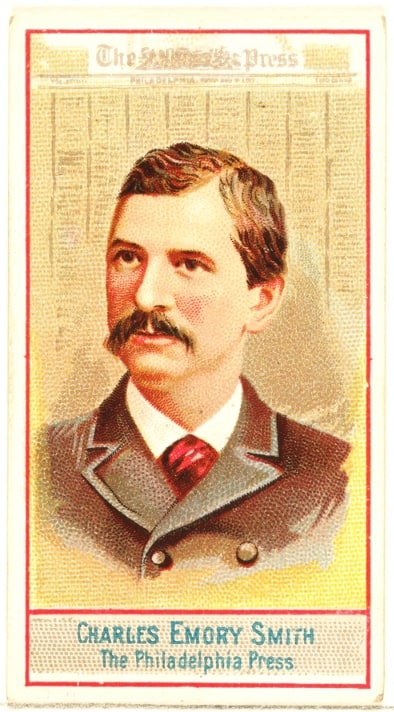
The newspaper article above summarizes the eloquent speech presented by Smith. It states:
Mr. Smith was introduced as author of the resolution of 1885 for making such a gift [the statue], and he eloquently presented a vision of a national Valhalla, where “The Pilgrim” should be with other types of divinities: the Cavalier, Teuton, [and] Huguenot, in a glorious circle around Quaker William Penn. The glorious fusion of the best strains of varied bloods into the composite American type should be represented in bronze statuary around City Hall and in Fairmount Park.
The elements of nationalities in this country were “as distinct as the billows, yet one as the sea.”
Their Pilgrim statue should stand with those of Washington, Franklin, Witherspoon, Lincoln, [and] Grant. It would speak of honor to worthy ancestry and the hope of posterity.
Note: According to sources the sculptor Augustus Saint-Gaudens was commissioned to create the bronze statue and paid $10,000 (about $356,930 today), with the assistance of Henry Hering and Francis Grimes.
Saint-Gaudens modeled “The Pilgrim” after one of his earlier sculptures, “The Puritan,” a statue commissioned by Chester W. Chapin to memorialize Deacon Samuel Chapin (1595–1675), one of the founders of Springfield, Massachusetts.
Here is an image, courtesy of Historical Marker Database, of the marker located in Fairmount Park, Philadelphia, that was erected by Museum without Walls.
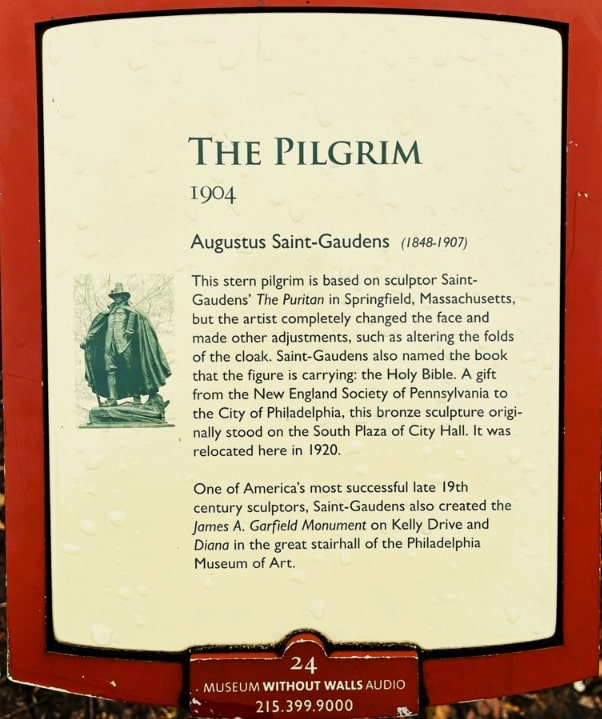
This historical marker reads:
The Pilgrim
1904Augustus Saint-Gaudens (1848-1907)
This stern pilgrim is based on sculptor Saint-Gaudens’ The Puritan in Springfield, Massachusetts, but the artist completely changed the face and made other adjustments, such as altering the folds of the cloak. Saint-Gaudens also named the book that the figure is carrying: the Holy Bible. A gift from the New England Society of Pennsylvania to the City of Philadelphia, this bronze sculpture originally stood on the South Plaza of City Hall. It was relocated here in 1920.
One of America’s most successful late 19th century sculptors, Saint-Gaudens also created the James A. Garfield Monument on Kelly Drive and Diana in the great stairhall of the Philadelphia Museum of Art.
Explore over 330 years of newspapers and historical records in GenealogyBank. Discover your family story! Start a 7-Day Free Trial
Note on the header image: close-up of “The Pilgrim” statue, Philadelphia, Pennsylvania. Credit: Smallbones; Wikimedia Commons.
Related Articles:
